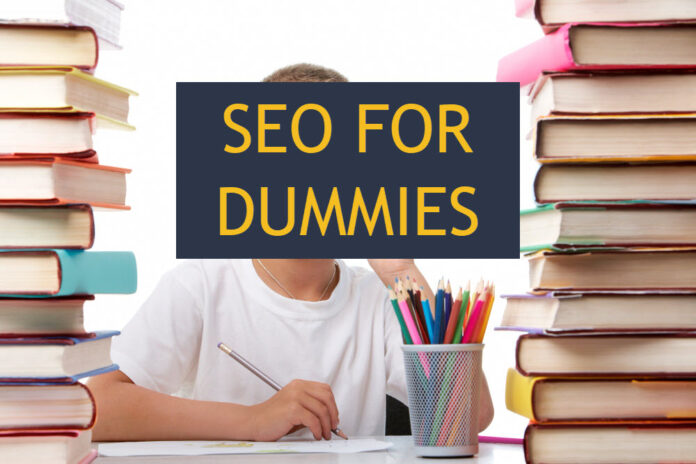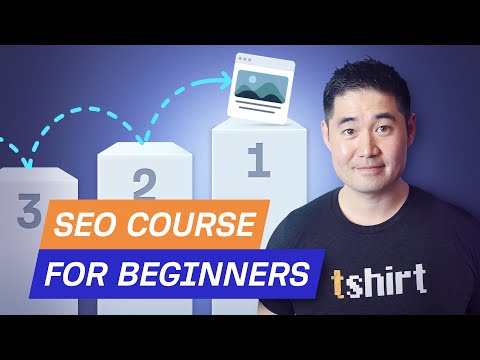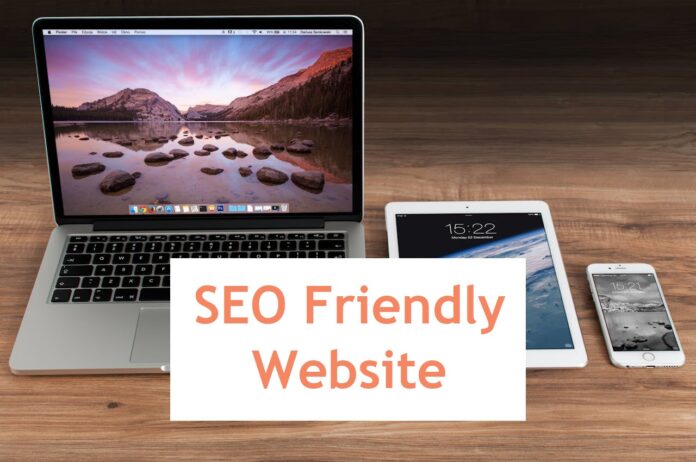Welcome to SEO for Dummies, your guide to the world of Search Engine Optimization (SEO). You may be a content creator or just curious about digital marketing. This article will help you uncover all you need to know about SEO.
On the internet, standing out among the vast content is not easy. SEO can be your savior to guide potential customers right to your doorstep. But what exactly is SEO? Why is it deemed crucial for your online presence? How can mastering it propel your business or personal brand?
SEO isn’t a buzzword or a passing trend; it’s the backbone of digital visibility. You can improve your website’s ranking on search engine results pages. They can attract a targeted audience and achieve your digital marketing goals.
We’ll journey through the history of SEO. You get insights into its evolution and the pivotal moments that have shaped it into what it is today. You’ll learn not just the ‘what’ but the ‘why’ behind each aspect of SEO.
You will understand the significance of keywords and backlinks. This blog will serve as your roadmap through the various types of SEO.
By the end of this guide, you will be conversant with SEO terms and phrases. You’ll also have a roadmap for furthering your SEO education. I hope it will inspire you to use this knowledge to scale new digital heights.
I’ve been in the Tech industry for over two decades now. I have seen the Cloud, Mobile, Internet, and Big Data impacting our daily lives. In my opinion, AI in SEO falls into the same league. A Microsoft survey concluded that 70% of their Generative AI users were more productive.
So, buckle up and prepare to demystify SEO. Together, we’ll explore this powerful digital marketing tool!
You can also download this full article as a PDF for convenient offline reading.
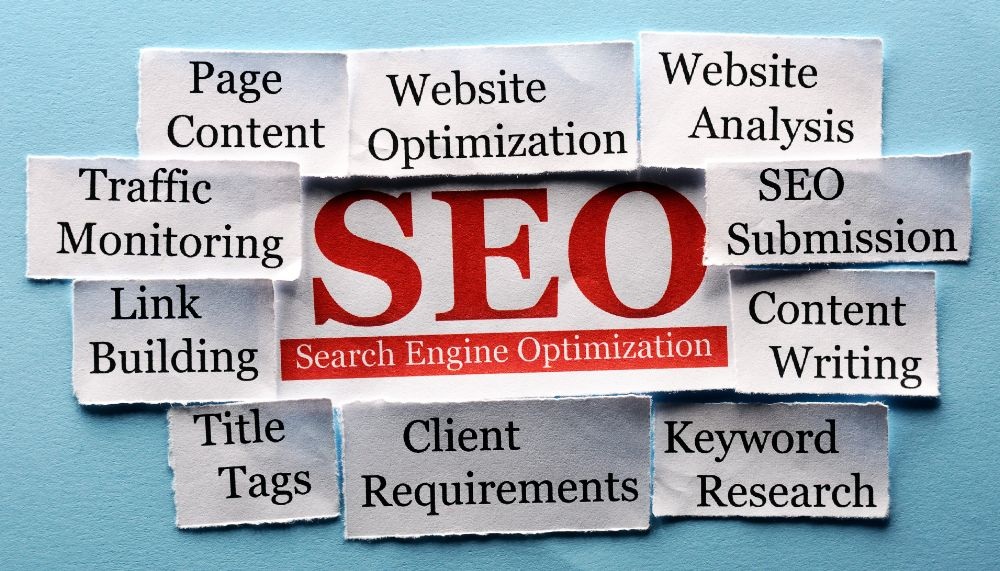
1. What Is SEO?
Search Engine Optimization, also called SEO, is a critical component of a digital marketing strategy. It aims to gain a website’s target ranking within search results. Simply put, it’s the art and science of making your website more amenable to search engines. They could be Google, Bing, or Yahoo.
SEO involves optimizing a variety of elements of your website. It ranges from the content on your pages to how other sites link to you. It is designed so that search engines can easily understand, index, and present your content. It is to cater to users searching for information, products, or services related to your offer.
The essence of SEO lies in understanding what people are searching online. You need to understand the type of content they want to consume and the words they use. By aligning your website’s content, you enhance its relevance and authority. It thereby increases the likelihood of ranking higher in search results.
This process helps to drive organic traffic to your site. It also improves the user experience. Overall, it aids in increasing the chance of visitors to convert into customers.
SEO is about speaking the language of your potential audience. It is your website that search engines should understand and rank your content higher in their results.
2. Why Should You Learn SEO? Why Is It Important?
Implementation of SEO strategies is crucial if you want to make an impact online. Here’s why learning SEO can be a game-changer for your business or personal brand:
- Enhances Visibility and Ranking: You ensure that your website appears higher on search engine results with SEO. It significantly increases the likelihood of attracting more visitors. A higher ranking means more visibility.
- Cost-Effective Marketing: SEO is an economical marketing strategy. Unlike paid advertising, SEO focuses on organic growth. It means you don’t have to pay search engines for a higher ranking. The investment is primarily in knowledge and time.
- Builds Credibility and Trust: Websites that rank high on search results are perceived as trustworthy and credible. SEO practices such as creating quality content help to gain users’ trust.
- Improves User Experience: SEO isn’t just about pleasing search engines. It’s also about providing a better experience for your visitors, from easy navigation to fast loading times and high-quality content. All these factors that boost your SEO also make your website more user-friendly.
Learning SEO is not just important; it’s essential in today’s digital age. You could be a multinational company, a small local business, or a personal blogger. SEO assists in the process of reaching your target audience effectively.

3. How Can SEO Help My Business?
SEO for business is not just another marketing tactic. It’s a critical component of your business’s growth strategy.
Here’s how SEO can significantly impact your business:
- Drives Targeted Traffic: SEO not just helps you attract more traffic, but the right kind of website traffic. You may optimize for specific keywords relevant to your products or services. A target audience looking for your offerings will be within reach. This process leads to higher conversion rates and revenues.
- Increases Brand Awareness: Ranking high on search engine results pages increases your brand’s visibility. The more frequently your site appears in search results, the more it gets noticed by potential customers. It reinforces brand recall and enhances brand awareness.
- Sustains Business Growth: SEO provides a foundation for continuous business growth. You need to optimize your website and adapt to search engine algorithms consistently. By doing this, you can maintain and improve your search rankings.
- Levels the Playing Field: SEO allows small and medium-sized businesses to compete with larger competitors. A well-optimized website enables you to rank alongside or even above more prominent brands. This ranking makes it possible to capture a significant share of the market.
SEO is a continuous process, not a one-time improvement and adaptation effort. The landscape of both the internet and consumer behavior is continuously changing. Integrate SEO into your strategy to build a path to contribute to your business objectives.
It’s about creating a user-friendly, fast, and robust website that ranks well. It will translate to more customers and increased conversion rates.
4. History of SEO in Brief
The history of SEO is closely tied to the evolution of search engines themselves. SEO’s journey began in the early 1990s with the dawn of the internet. With the internet, the first search engines emerged to help users navigate the growing web.

Web admins simply used to submit URLs to search engines in the early days. It would then index the site and include it in search results. This rudimentary approach quickly evolved. Website owners began to recognize the value of ranking higher to attract visitors.
- Early 1990s: The advent of the first search engines, like Archie and AltaVista. It marked the beginning of search engine optimization. The term SEO, though, wasn’t widely used then.
- Mid to late 1990s: Major search engines like Yahoo! and Google were launched. Around this time, SEO began to gain prominence. Web admins started to optimize websites by stuffing keywords. They manipulated meta tags to improve rankings.
- Early 2000s: Google introduced its PageRank algorithm. It was the first focus on the importance of backlinks. This period saw the rise of “white hat” and “black hat” SEO practices. These practices lead to more sophisticated strategies for improving rankings.
- 2010s to present: The SEO landscape has become increasingly complex. Google’s algorithm had updates like Panda, Penguin, and Hummingbird. It emphasizes quality content, mobile-friendliness, and user experience. AI and machine learning refined how search engines understand and rank content.
The evolution of SEO reflects the constant pursuit of a more organized internet, from simple key word stuffing to the sophisticated practices of today. SEO has grown into a vital discipline. It keeps the web a competitive space for businesses and content creators.
Understanding its history provides you a context. It highlights the importance of staying adaptable to constant changes.
5. What are the Types of Search Engine Optimization?
Search Engine Optimization (SEO) can be broadly categorized into three main types. Each of them serves a unique purpose in the overall strategy. They help improve a website’s visibility and ranking on search engines. These are On-Page SEO, Off-Page SEO, and Technical SEO.
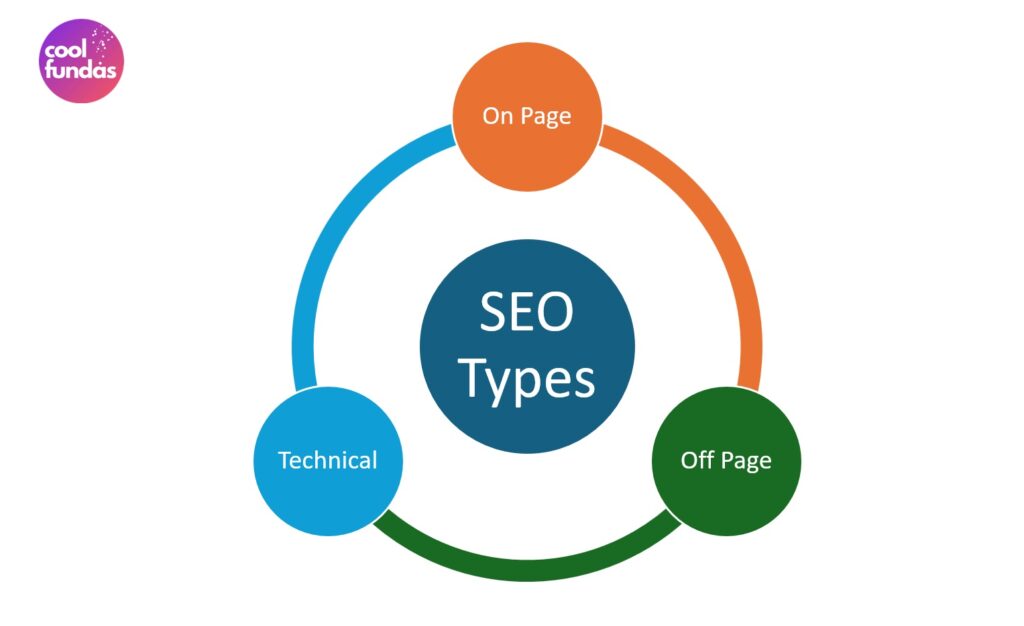
On-page SEO is about optimizing the webpage’s HTML source code and content. It is done for the individual web pages. You make them more relevant to specific keywords for search engines to index. Key elements include:
- Optimizing title tags, meta descriptions, and headers.
- Producing relevant, high-quality content that addresses the needs of your audience.
- Using keywords effectively within your content.
- Optimizing images through file names, alt text, and image sizing.
Off-page SEO is on external factors that impact your site’s search rankings. It is concerned with building the site’s reputation and authority through:
- Get good quality backlinks from reputed sites related to your business.
- Social media marketing to enhance visibility and traffic.
- Guest blogging and content marketing to establish authority for backlinks.
Technical SEO refers to optimizing the infrastructure of your website. You will help the search engines crawl and index your website easily. Technical SEO includes:
- Improving site speed and mobile-friendliness.
- Creating a structured data markup.
- Ensuring a secure connection through HTTPS.
- Optimizing your site’s architecture and URL structure.
Integrate all the SEO types to create a comprehensive optimization approach. It also improves searchability and the overall user experience.
6. How Do Search Engines Work?
Search engines are like librarians for the vast internet content. They organize the world’s information to be universally accessible and helpful. Search engines perform three primary tasks at their core: crawling, indexing, and ranking.
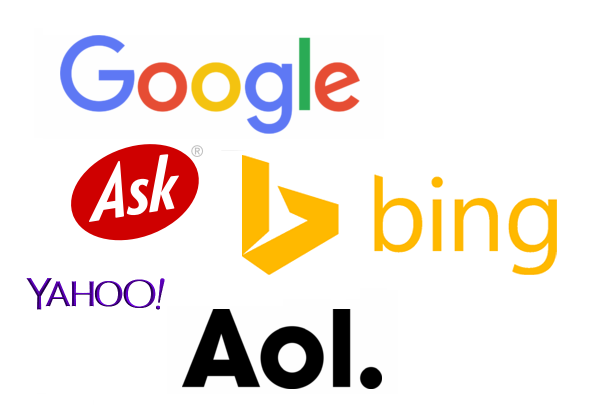
Search engines scrap publicly available web pages through a process called crawling. They use bots, known as crawlers or spiders, to do this. These bots traverse the web by following links from one page to another. They collect information on each webpage they visit.
This continuous process aids in the discovery of new pages and updates to existing pages. These are added to the search engine’s database.
Once a webpage is crawled, it’s then indexed. Indexing involves storing and organizing the content found during the crawling process. When a page is indexed, it is stored in a vast database from where it can be quickly retrieved.
The final and most critical step is ranking. When you run a search, the engine looks at its index to present the most relevant results. This step is where search algorithms come into play.
They analyze several factors like keywords on a page, the quality and quantity of content, the user’s device, etc. It’s a complex and dynamic process. It is designed to serve the most accurate and relevant responses to a user’s search.
7. Types of Searches
Understanding this is crucial for optimizing content and improving a website’s visibility. Broadly, searches can be classified into three main categories: navigational, informational, and transactional.
- Navigational Searches are with the intent of reaching a specific website or webpage. Users already have a destination in mind. An example is a social media platform or a particular company’s homepage. They use the search engine to get there quickly. Optimizing for navigational searches involves ensuring your website is easily identifiable. They should be accessible through direct queries of your brand or product names.
- Informational Searches encompass queries where users seek answers, information, or guidance. This search may not necessarily be for making a purchase. It can range from simple facts or weather forecasts. They could also be more complex tutorials or guides. For SEO, targeting informational searches means creating valuable, engaging content. It should be with details that people are likely to use when seeking information.
- Transactional Searches indicate a user’s intent to complete an action or purchase. These searches are crucial for e-commerce and businesses. They are looking to attract customers who are ready to buy. Keywords for transactional searches often include specific key terms. Examples are “buy,” “deal,” “discount,” or product-specific terms. Optimizing for these searches involves highlighting products, services, and offers. Efforts should be made to make the buying process seamless.
Understanding these search types helps in tailoring SEO strategies more effectively. Businesses can align their web content with the intentions of their target audience. By recognizing the nature of the search, they optimize the website to cater to the user’s exact needs.
8. Keyword Research Basics
Keyword research is the heart of an effective SEO strategy. It is the compass for creating content to meet your target audience’s search queries.
It is the process of figuring out the words or phrases that potential customers use while searching. This search is for products, services, or information about their needs. The goal is to figure out the most popular search terms. You also need to understand other ways people might express their search intent.
This process enables you to tailor your content strategy to align with user queries. It helps increase the website’s visibility on search engine results pages (SERPs).
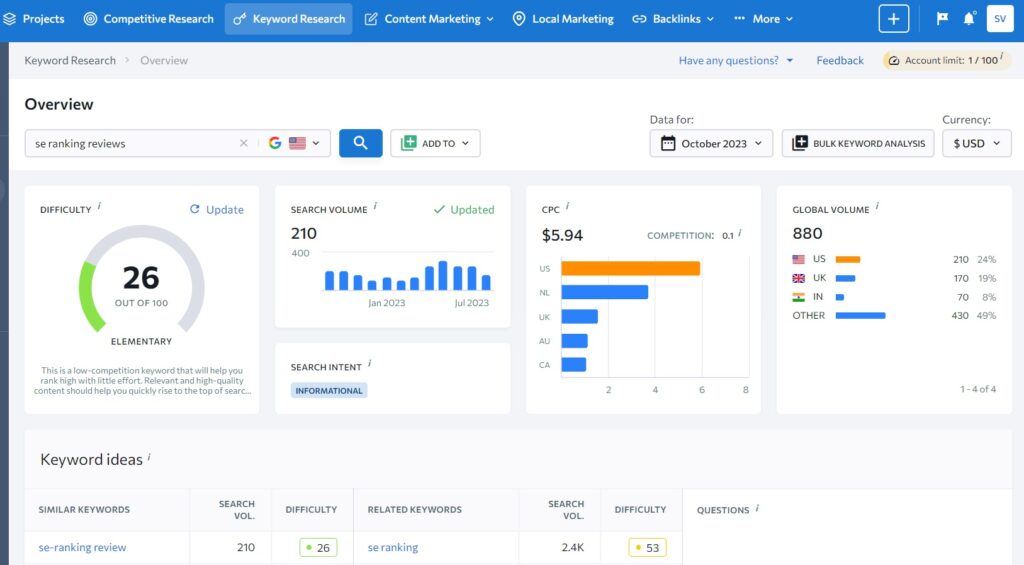
The basics of keyword research involve several vital steps:
- Brainstorming initial key word ideas. This step is based on your understanding of your industry, products, and services.
- Key word research tools can be used to expand the list. Examples of research tools are Google Keyword Planner, Semrush, SE Ranking or Ahrefs. It helps you uncover related search terms and phrases. You also get to know their search volume and competition level.
- Consider both ‘short-tail’ keywords and ‘long-tail’ keywords. Short keywords that are broad and often more competitive. Long keywords are more specific phrases with lower search volumes. They typically show closer intent, which leads to better conversion rates.
- Analyze your competitors’ keyword strategies. You can understand gaps in your strategy or areas for improvement.
With these basic steps, you can create a targeted approach to attract qualified traffic. It will improve your overall SEO performance.
9. Backlinks and Their Significance
Backlinks are links on another webpage to an article/image/video on your website. They are also known as inbound links or external links. They play a pivotal role in a website’s search engine ranking. Search engines recognize backlinks as a measure of confidence.
A website linking to your webpage sends positive signals to search engines. Your content is assumed to be valuable, credible, and useful. The quality and quantity of these backlinks significantly influence your site’s authority. The Site Authority affects your rankings in search engine results pages (SERPs).
High-quality backlinks from reputable and relevant sites can boost your site’s visibility. They drive organic traffic and enhance your online reputation.
However, not all backlinks are created equal. The significance of backlinks extends beyond mere numbers. The authority and relevance of the sites from where it is linked decide the value of a backlink.
Search engines use sophisticated algorithms to check the quality of backlinks. They consider factors such as the linking site’s topical relevance to your site. They also consider the link’s placement and the anchor text used in the link.
This linking means that backlinks from authoritative sites can significantly impact your SEO. Links from low-quality or unrelated sites have no significance.
Engaging in ethical link-building practices is essential. Manipulative tactics to get backlinks can lead to penalties from search engines. They can damage your site’s ranking, credibility, and authority.
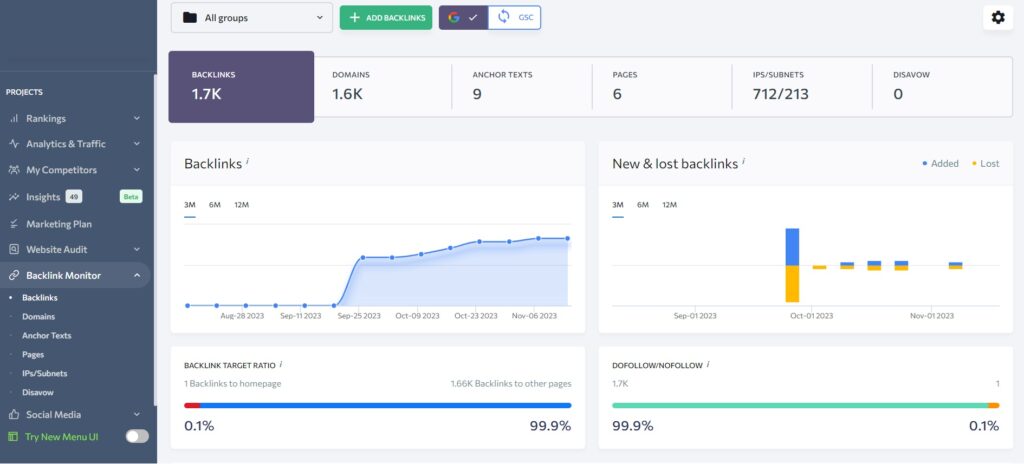
10. User Experience Fundamentals
User Experience, or UX, is a crucial aspect of SEO that determines the success of a website. UX ensures visitors have a seamless interaction with the site content.
UX includes several aspects to be considered. Some of these are site speed, ease of navigation, mobile responsiveness, and the quality of content. A superior user experience helps to keep visitors engaged.
It reduces bounce rates and encourages them to explore more pages on your site. Search engines interpret them as signals of a site’s value and relevance. Google’s algorithm updates underscore the importance of UX.
Implementing UX fundamentals begins with understanding your audience. Also, study how they interact with your website. This understanding helps to design a clear, intuitive site navigation structure. It enables users to find the information they seek effortlessly.
Mobile friendliness is paramount. A significant part of today’s online traffic comes from mobile devices. Websites must be optimized for these users. It should provide a consistent and enjoyable experience across all devices.
Page loading speed is also a critical factor. Websites that load quickly please users and are favored by search engines. Finally, content quality and accessibility are vital.
The content on the page should be straightforward to read and engaging with valuable information. They should be with proper use of headings and bullet points.
Multimedia elements enhance readability and engagement. By prioritizing these user experience elements, websites can significantly improve their SEO performance.
11. Good Content & Google EEAT
In SEO, the quality of content on your website cannot be overstated. Good content is to engage readers. They provide value and establish your site as an authority in your field. Google focuses on EEAT—Expertise, Experience, Authoritativeness, Trustworthiness. It emphasizes the need for high-quality content.
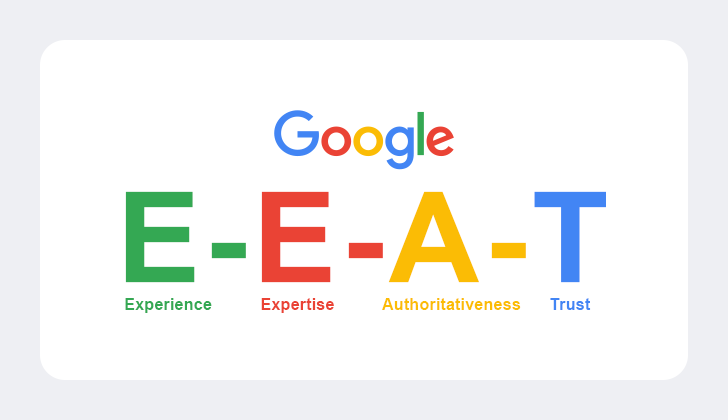
Their guidelines are part of Google’s broader effort. It is to ensure that searchers are presented with relevant information. It should be from credible and authoritative sources. Here’s what forms good content as per Google’s EEAT criteria:
- Expertise: Your content should reflect the author’s sound understanding of the subject. It means providing in-depth, accurate, and helpful information. For individuals, it means showcasing qualifications. You could also include experiences that affirm your expertise on the topic.
- Experience: Ensuring the content is based on the author’s first-hand experience is essential. A reviewer should show that they have personally experienced the subject being covered. For example, has the author actually used the products they are recommending? Has a writer used the software they are reviewing?
- Authoritativeness: Establishing your website or authors as authorities on the subject. This can be achieved through citations from reputable sources. It could also be achieved through recognition from within your industry. Your content should be widely referenced and shared across the web.
- Trustworthiness: Ensuring that your website and content are reliable and secure. Trustworthiness can be enhanced by having a secure site (HTTPS). It should showcase transparent authorship and site ownership. It should provide clear, accurate information without misleading users.
Adhering to the EEAT guidelines is vital for any content creator or SEO practitioner. It is the proven way to improve their site’s performance in search results. It’s about moving beyond keyword optimization and link-building. The focus is always on the real value to your site visitors.
It’s time to focus on creating content that meets the EEAT guidelines. It is the best way to build an audience base that views your site as a go-to resource in your niche.
12. Inspiration from Competitors
Learning from your competitors is a strategic approach in SEO. It provides valuable insights into what is useful and what isn’t. Analyzing your competitors’ online presence can reveal opportunities for improvement. You can innovate in your SEO tactics.
Here’s how to draw inspiration from your competitors:
- Keyword Strategy: Examine the keywords your competitors target in their content and SEO efforts. Tools like Semrush or Ahrefs can help you identify these keywords. Analyzing their strategy can uncover gaps in your keyword list. You can figure out new keyword opportunities to explore.
- Content Analysis: Review the type of content earning your competitors backlinks and engagement. This content could include blog posts, infographics, videos, and other formats. Understanding what resonates with your shared audience can guide your content creation strategy. It encourages you to produce content that is as engaging or better.
- Backlink Profile: Investigate where your competitors are getting their backlinks from. Identifying these sources can offer you new ideas for your link-building efforts. They include potential websites to target for link-building strategies.
- User Experience (UX) and Site Structure: Look at how competitors structure their websites and the user experience they offer. Is their site more navigable or faster than yours? Learning from their site design can inspire improvements to your site’s UX.
Inspiration from competitors does not mean imitation. It’s about learning from their successes and shortcomings. You can then use the learnings to refine your SEO strategy. It helps when you can easily find areas to improve your website and differentiate itself.
This competitive analysis should be an ongoing part of your SEO strategy. It ensures you remain aware of industry trends and stay ahead in search engine rankings.
13. Key Metrics to Track
Diving into the world of SEO metrics can feel overwhelming. It is complex and offers detailed insights into each aspect. Mastering and understanding all the available metrics can take time for those new to SEO.
However, getting familiar with a core set of metrics is crucial to measure your SEO efforts.

As a starting point, here are the top 5 SEO metrics for beginners to focus. They will help you make informed decisions on your way forward:
- Organic Traffic: The traffic coming to your site through the search engine. It only refers to those visiting without paid promotion. This metric is a direct indicator of your SEO performance. It reflects the effectiveness of your keyword strategy and content relevance.
- Keyword Rankings: The position of your website’s pages in search engine results for specific keywords. Tracking changes in keyword rankings helps gauge the effectiveness of your optimization efforts.
- Bounce Rate: It is the percentage of visitors who navigate away from your site after viewing only one webpage. A high bounce rate may show your content is not meeting the audience’s expectations. It could also mean that your page is not user-friendly.
- Page Load Time: The speed at which your pages load for users. Page speed is a critical UX factor influencing your bounce rate and SEO rankings. Search engines favor fast-loading sites, which is an important ranking factor.
- Backlinks: The number and quality of external sites linking to your website. Backlinks are a vote of confidence from other sites. They are a significant factor in building your site’s authority and search rankings.
These metrics provide a solid foundation for beginners to assess their SEO performance. By focusing on these key areas, you can start getting a handle on how well your site performs. You can focus on where to make improvements.
Over time, you will become comfortable with the metrics. As you grow with the website, you can explore more metrics. Examples are click-through rates (CTR), conversion rates, and aspects of user engagement.
You should remember – SEO is a long-term strategy. Success comes from continuous learning, testing, and optimization of metrics.
14. Twelve Steps To Build An SEO-Friendly Website
Creating a website that is friendly to search engines and users is crucial. An SEO friendly website ranks higher in search engine results. It also provides a better user experience.

Here are 12 fundamental steps to building an SEO Friendly website:
- Start with a Mobile-First Approach: Designing your website for mobile users is essential. This approach is considering the dominance of mobile browsing in today’s time. You must make the website responsive and ensure it loads on all devices.
- Intuitive Site Structure: Organize your site’s structure logically with a clear hierarchy. This process helps search engines quickly crawl your site’s content and supports user navigation.
- Secure Your Site with HTTPS: Security is a top priority for search engines and users. Migrating to HTTPS protects your site and can positively impact your rankings.
- Optimize Your URLs: Create clear, descriptive URLs for each page. Include target keywords where relevant. Make them easy to read for both users and search engines.
- Focus on High-Quality Content: Produce valuable, informative, and relevant content to your audience. Quality content is critical to engaging users. It improves your site’s authority and relevance.
- Optimize Meta Descriptions and Title Tags: These elements should describe the webpage’s content in a few words. The description should include target keywords. They are crucial for improving click-through rates from search engine results pages.
- Use Header Tags to Structure Content: Proper use of header tags (H1, H2, H3) helps organize content. It is easier for readers to navigate and search engines to use these inputs about your page contents.
- Incorporate Keywords Strategically: Avoid keyword stuffing and ensure your keywords are part of the content naturally. It is especially needed in titles, headers, and through the body text. Make sure you have considered primary and related keywords,
- Optimize Images: Use alt tags for images and descriptive file names. You can improve page load times by compressing images without sacrificing quality.
- Internal Linking: This step links to other relevant pages on your website. It helps search engines discover more of your content. They will understand the relationship between pages. It showcases your expertise in a particular topic.
- Build Quality Backlinks: Earn backlinks from reputable sites within your industry. They boost your site’s credibility and search engine ranking.
- Regularly Track Your SEO Performance: You can use tools like Google Search Console and Google Analytics. They help to track your website’s performance. You can understand your audience and identify areas for improvement.
These tips will set a strong foundation for your website’s SEO strategy. It ensures that you are well-positioned to engage more visitors through higher rankings.
15. Need For Search Engine Optimization Tools
It is crucial to optimize your website for search engines. Utilizing the right SEO tools can significantly enhance your efforts. For beginners, it’s essential to start with powerful and user-friendly tools.
Below are key points highlighting the importance of SEO tools:
- Invaluable Insights: SEO tools provide critical data on your website’s performance. It includes keyword rankings, backlink analysis, and competitive insights.
- Streamline Efforts: These tools help simplify various SEO tasks. They conduct on-page audits to track your rankings, backlinks, etc.
- Functionality Coverage: The selected tools can help you discover and analyze keywords. The tools can audit your website for on-page SEO and conduct competitive analysis.
- Economical for Beginners: There are many free tools as well as budget friendly SEO tools for beginners. They are user friendly and easy to adopt.
See my related article on 5 Best SEO Tools For Beginners
16. What Next for In-depth SEO Education
This article intends to lay the groundwork for the basics of SEO. Delving into advanced concepts and strategies is the next step. This step is necessary if you are looking to excel in this field.
There is a wealth of resources available online for detailed SEO education. It ranges from articles and guides to comprehensive courses and video tutorials.
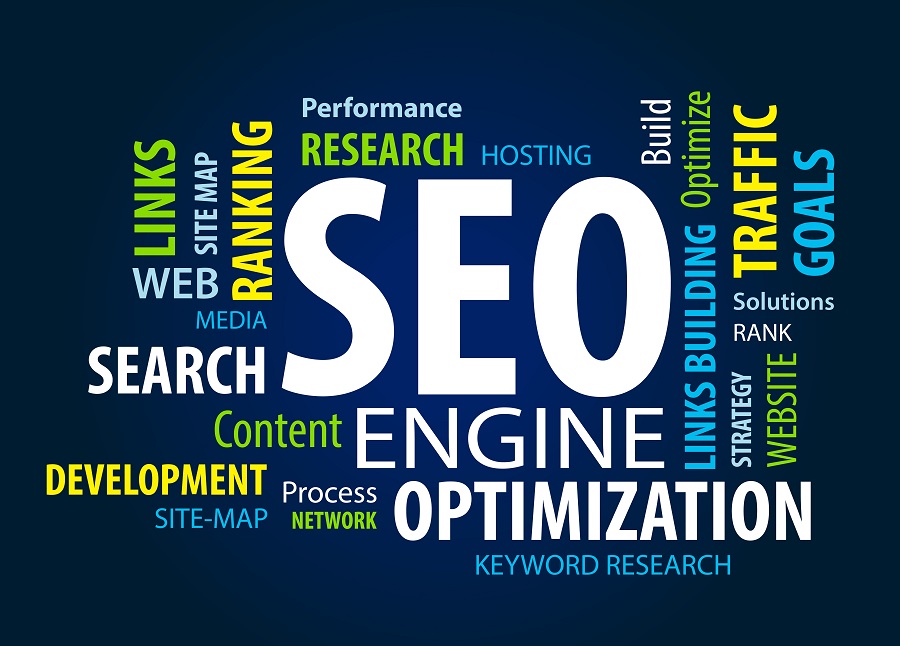
Here are some references to high-quality content for further learning:
- Search Engine Journal: It is renowned for its in-depth articles, case studies, and how-to guides. Search Engine Journal is a treasure trove of SEO knowledge, basic to advanced. Topics cover the latest trends, algorithm updates, and innovative strategies. They are well-written to help you stay ahead.
- HubSpot: HubSpot’s blog and academy offer extensive resources on SEO. They also cover broader digital marketing tactics. Their content marketing and SEO guides are particularly valuable. You get an understanding of how to create content that ranks well.
- YouTube Videos: Channels like Moz, Neil Patel, and Brian Dean (Backlinko) provide insightful video content. They break down complex SEO concepts into understandable chunks. They offer practical advice and tips that you can implement immediately.
- MOOCs by Reputed Universities: Platforms like Coursera, edX, and Udemy feature courses on digital marketing and SEO. They are from respected and world-renowned institutions. These courses often include the latest research and practices in the field. They are taught by industry experts and accomplished university faculty.
- SEO Conferences and Webinars: Participating in SEO conferences and webinars is useful. It is a great way to learn from leading experts and network with peers. Check out events like MozCon, SMX, Brighton, and Chiang Mai SEO. They offer sessions on cutting-edge SEO strategies and future trends. Most have online entries if you cannot go in person.
Advancing your SEO education requires a commitment to continuous learning and staying updated. The search engine algorithms and best practices are constantly evolving. By leveraging these resources, you can deepen your understanding of SEO.
You can choose your preferred medium of learning. Read detailed articles, watch videos, or complete structured online courses. A wealth of knowledge is available to help you become an SEO expert.
Here’s a concise and complete course on SEO for Beginners:
17. Twenty-Five SEO Terms and Phrases You Should Know
- SEO (Search Engine Optimization): An activity aimed at improving the quality and quantity of traffic to your website. This traffic is through organic search engine results.
- Search Engine Results Page: Also called SERP is the webpage showing responses to a user’s search query. They may contain both organic and paid listings.
- Keyword: A word or phrase entered by users in a search engine to find the information they need.
- Backlink: A link from one website to another. Search engines view this link as a vote of confidence in the quality of your content.
- Domain Authority Score: It is a search engine ranking indicator for your website. The one developed by Moz is well respected.
- PageRank: It is an algorithm used by Google search engine to rank websites and their pages. There are several ranking factors that contribute to your page ranking.
- On-Page SEO: It is the process of optimizing individual pages within a website. The aim is to rank higher and earn relevant traffic in search engines.
- Off-Page SEO: These are techniques used to improve a website’s position in the search engine results. It is through activities outside of the actual website. Examples are backlinks, social media, etc.
- Meta Tags: They are snippets of text used to describe a page’s content. They help search engines figure out the page content easily.
- Alt Text: It describes an image in your site’s HTML code. Search engines use this text to understand the image content.
- Anchor Text: In any hyperlink, Anchor Text is the text you click. It is often optimized with keywords for SEO.
- Crawl: It is the process by which search engines discover your web pages. It is by following links from one page to another.
- Indexing: It is the process of storing and organizing content. The content is found during crawling by search engines. It allows search engines to serve relevant content to users quickly.
- Organic Traffic: Those visiting your website from search engine listings that are not paid for, which means not from paid advertisements.
- PPC (Pay-Per-Click): It is an internet marketing model where advertisers must pay each time their ad is clicked.
- CTR (Click-Through Rate): It is the % visitors who click on a specific link out of the total visitors who view the page.
- Bounce Rate: It is the % visitors who go away to your website after interacting with just one page.
- Canonical Tag: An HTML element that helps web admins prevent duplicate content issues. It is by specifying a web page’s “canonical” or “preferred” version.
- 301 Redirect: It is often used when a site or page has moved to a new domain. It is a permanent redirect from one URL to another.
- 404 Error: It is an HTTP status code indicating that the page a user was trying to reach could not be found on the server.
- Schema Markup: It is the code (semantic vocabulary) that you put in your website. It is to help search engines return relevant results for users.
- Black Hat SEO: This class of aggressive tactics focuses only on search engine rankings and not necessarily the end user. They often violate search engines’ terms of service by employing unethical means.
- White Hat SEO: SEO tactics that focus on a human audience as opposed to search engines. They completely follow search engine rules and policies in letter and spirit.
- Google Analytics: It is an analytics tool by Google to track and report website traffic. It is available for free.
- Google Search Console: It is used to track and maintain your website using Google Search results. This one is also available for free by Google.
18. Wrap-Up of SEO For Dummies
Embarking on the SEO journey can seem daunting at first. As we’ve explored in this guide, mastering the fundamentals of SEO is within reach for everyone.
You may have understood what SEO is and why it’s critical for your online presence. You now have the knowledge to improve your website’s visibility and ranking.
I want to reiterate that SEO is a marathon. It is not a sprint; continuous learning and adapting to search engine algorithm changes is an ongoing activity. Refining your strategies over time will lead to sustained success. With these tools and concepts, you are all set to begin your journey to becoming an SEO expert.
I would love to know if you found this SEO introduction helpful.
You can also download this article as a PDF for convenient offline reading.

